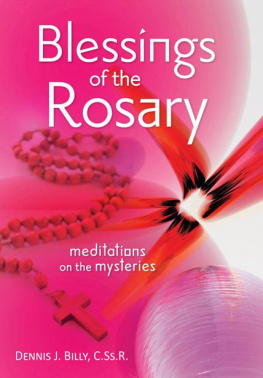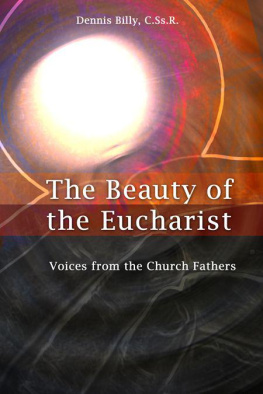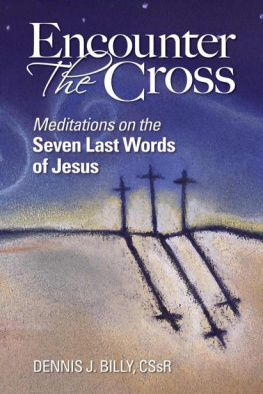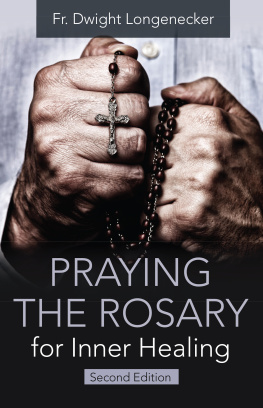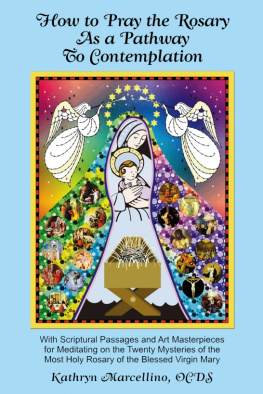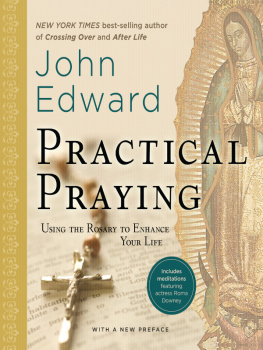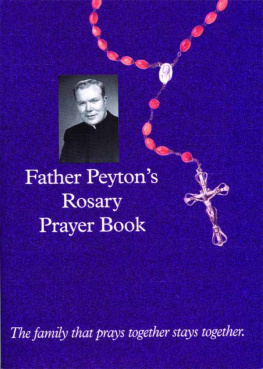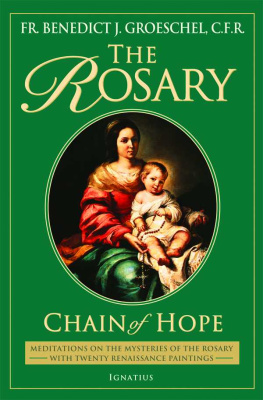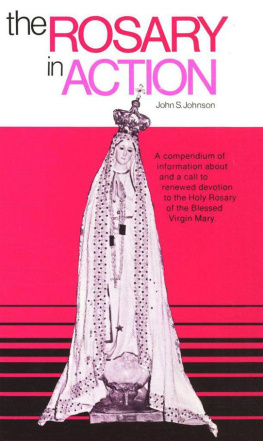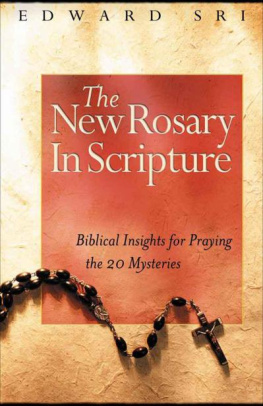A LSO BY D ENNIS J. B ILLY , C.S S .R.
Experiencing God: Fostering a Contemplative Life
Plentiful Redemption:
An Introduction to Alphonsian Spirituality
Simple, Heartfelt Words:
Preaching in the Alphonsian Tradition
Soliloquy Prayer: Unfolding Our Hearts to God
There Is a Season: Living the Liturgical Year
The Way of a Pilgrim:
Complete Text and Readers Guide
With Open Heart:
Spiritual Direction in the Alphonsian Tradition
Blessings
of the
Rosary
meditations
on the mysteries
D ENNIS J. B ILLY , C.S S .R.

Imprimi Potest: Thomas D. Picton, C.Ss.R.
Provincial, Denver Province, The Redemptorists
Published by Liguori Publications, Liguori, Missouri
To order, call 800-325-9521 or visit www.liguori.org
Copyright 2010 Dennis J. Billy
All rights reserved. No part of this publication may be reproduced, stored in a retrieval system, or transmitted in any form or by any meanselectronic, mechanical, photocopy, recording, or any otherexcept for brief quotations in printed reviews, without the prior written permission of Liguori Publications.
Library of Congress Cataloging-in-Publication Data
Billy, Dennis Joseph.
Blessings of the rosary : meditations on the mysteries / Dennis J. Billy. 1st ed.
p. cm.
ISBN 978-0-7648-1943-8
1. Mysteries of the Rosary. I. Title.
BT303.B55 2010
242.74dc22
2010009689
Scripture texts in this work are taken from the New American Bible with Revised New Testament and Revised Psalms 1991, 1986, 1970 Confraternity of Christian Doctrine, Washington, D.C. and are used by permission of the copyright owner. All Rights Reserved. No part of the New American Bible may be reproduced in any form without permission in writing from the copyright owner.
John Paul II, Rosarium Virginis Mariae, Apostolic Letter on the Most Holy Rosary,
October 16, 2002. Copyright 2002 Libreria Editrice Vaticana.
Liguori Publications, a nonprofit corporation, is an apostolate of the Redemptorists. To learn more about the Redemptorists, visit Redemptorists.com.
Printed in the United States of America
14 13 12 11 10 5 4 3 2 1
First Edition
In honor of
Mary, the Mother of God,
Our Mother of Perpetual Help
Christ is the supreme Teacher, the revealer and the one revealed. It is not just a question of learning what he taught but of learning him. In this regard could we have any better teacher than Mary? From the divine standpoint, the Spirit is the interior teacher who leads us to the full truth of Christ (see Jn 14:26; 15:26; 16:13). But among creatures no one knows Christ better than Mary; no one can introduce us to a profound knowledge of his mystery better than his Mother.
P OPE J OHN P AUL II
R OSARIUM V IRGINIS M ARIAE , 14
CONTENTS
INTRODUCTION
On a recent visit to New Yorks Metropolitan Museum of Art, I was wandering through a display of medieval art when I came upon a wooden carving the size of a small grapefruit called Rosary Bead. The beads exterior was intricately designed with a variety of Christian symbols, including crosses, candles, and doves. What surprised me about this piece, however, was not its exterior, but the way it opened to reveal in its interiorin even more finely crafted detaila three-dimensional scene of Christs crucifixion.
The artist had gone to great pains to recreate the scene of Jesus death. Everything was there: Christ on the cross, the two thieves, Mary, the women and the beloved disciple at the foot of the cross, the soldiers, the crowd, the darkened skyand all within a space the size of a grapefruit! Minute as they were, the details were so vivid that I could actually make out the crown of thorns on Jesus head, the wounds in his hands and feet, and the blood pouring down the wound at his side.
I felt as though I was peering into another world. The mystery of Christs passion and death had come to life within this small internal space. All I could do was stare into it and contemplate its meaning. I gradually saw that the craftsman was trying to reveal Christs paschal mystery concealed within the bead itselfin this case, the crucifixion. We ourselves do much the same thing when we pray the rosary and reflect on its mysteries: We pray it so that its mysteries will come alive for us and help shape the way we view ourselves, others, and the world we live in.
The rosary is a simple prayer deeply rooted in the Catholic tradition. It can be prayed aloud or in silence, in private or in a group. Its purpose is to immerse us in the mysteries of the Christian faith through heartfelt prayers to Jesus and his mother, Mary.
Traditionally consisting of fifteen decades of one Our Father, ten Hail Marys, and one Glory Be to the Father, the rosary has often been called the poor mans Psalter. These fifteen decades, which reflect the 150 Psalms of the Old Testament, were a means of giving the poor and illiterate a way to participate more deeply in mysteries of the faith.
The traditional fifteen decades are further arranged into five Joyful, five Sorrowful, and five Glorious Mysteries, which relate respectively to the Incarnation, Christs passion and death, and the glories of Jesus and Mary. For those wishing to penetrate the Gospel message ever further, Pope John Paul II added five Luminous Mysteries (also called Mysteries of Light) relating to Jesus public ministry. This addition expands the traditional arrangement to a full twenty decades.
In response to Pope John Paul IIs 2002 call for theologians to help the Christian people to discover the Biblical foundations, the spiritual riches and the pastoral value of this traditional prayer (On the Most Holy Rosary [Rosarium Virginis Mariae], 43), this book offers a profound meditation on each Mystery of the twenty-decade rosary. My aim is to provide a prayerful reflection on each Mystery and then ask probing questions that will help readers deepen their awareness of Gods action in their lives.
These meditations on the Mysteries of the Rosary are not only for newcomers to this venerable prayer form, but also for those who already practice it regularly and are interested in making it an even more integral part of their lives and daily devotion.
HOW TO USE THESE REFLECTIONS
Depending on the inclinations and needs of the reader, this book can be used for spiritual reading or in conjunction with the actual recitation of the rosary. It can be read in parts on the specific days allocated to each Mystery: the Joyful (Monday and Saturday), the Luminous (Thursday), the Sorrowful (Tuesday and Friday), and the Glorious (Wednesday and Sunday). It can also be read in conjunction with the liturgical seasons: the Joyful (Advent and Christmas), the Luminous (Ordinary Time), the Sorrowful (Lent) and the Glorious (Easter). Readers should use the book in whatever way they think will help them ponder more deeply the mysteries of this beautiful prayer in the recesses of their hearts. Such was Marys way. By following it, we will be sure to walk in the footsteps of her Son.
With the Rosary, the Christian people sits at the school of Mary and is led to contemplate the beauty on the face of Christ and to experience the depths of his love (RVM, 1). These words of Pope John Paul II remind us why we pray the rosary. I hope these meditations on the twenty-decade rosary immerse readers in the waters of Gods love and help them share it with others.
The school of Mary is first and foremost a school of Christian discipleship. As we finger the beads of her rosary, may the mysteries they represent open our minds to Christs presence in our lives and, like Mary, help us respond to his call with every fiber of our being.

